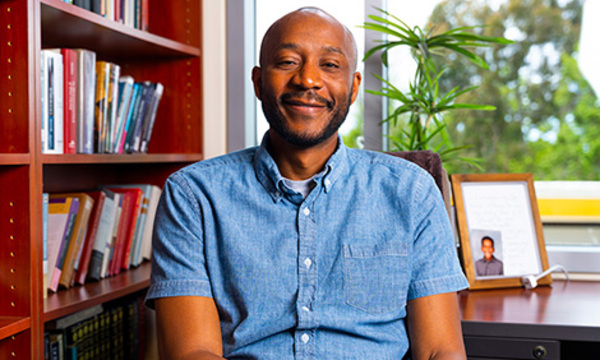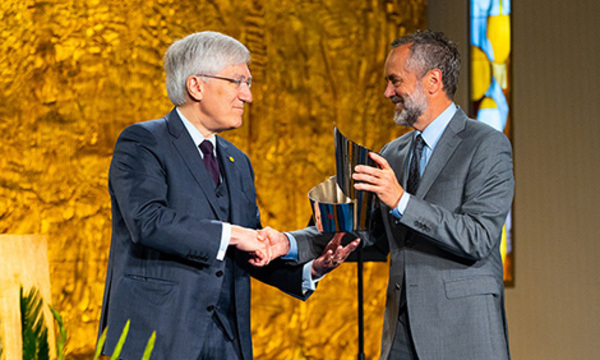The story of the Bible is fascinating, encouraging and a tribute to the grace of God working through many different people over the centuries.
How well do you know this story?
Here, Talbot professor Clinton E. Arnold — author of the recently released How We Got the Bible: A Visual Journey (Zondervan, 2008) — offers eight questions that put your knowledge of Bible history to the test. See how many you can answer.
1. What is the oldest form of the Old Testament text ever to be discovered? (Clue: It was discovered as recently as 1979.)
During an excavation of a burial tomb near Jerusalem in 1979, archaeologists discovered two thin, silver rolls containing the priestly blessing from Numbers 6:24–26. The rolls were dated to the seventh century B.C., making them the oldest form of any portion of the Hebrew Bible ever found. Gordon Franz, who often does the on-site teaching in Israel for the Talbot Bible Lands trips, was the dig supervisor where the 2,700-year-old silver texts were found.
2. What was the first Bible ever to be printed in America? (Clue: It was not the King James Version.)
The first Bible ever printed in the New World was not in English, French or German, but in Algonquin. An English Puritan named John Eliot (1604–1690), responding to God’s call to be a missionary to the Native Americans near the Massachusetts Bay, translated both the Old and New Testaments into their language. By 1674, there were 4,000 converts among 14 different villages.
3. What was the biggest manuscript of the Bible ever made and how many donkeys needed to supply their skin for its pages?
It is reported that it took the skins of 160 donkeys to supply enough parchment to produce “Codex Gigas,” the largest and heaviest Bible ever made. The manuscript weighs 165 pounds and each leaf measures 20 inches by 36 inches. It was made in the 13th century in a Benedictine monastery in Bohemia and contains the text of the Latin Vulgate.
4. Who was the first to translate portions of the Bible into English?
Caedmon, who lived on the Yorkshire coast in England in the mid-seventh century, has the distinction of being the first to translate some of the Bible into English. He took portions of the Latin Vulgate and crafted them into songs for the benefit of the common people.
5. How did William Tyndale import copies of his English Bible into England from the continent in the mid-1500s?
The only way for Tyndale to get his recently published English Bibles into England from the continent was to smuggle them. He did so by hiding them in bales of cotton and other containers. The Bishop of London found out and had as many of the Bibles as he could find gathered and burned.
6. A few years ago, workmen accidentally broke through the wall of a famous monastery and discovered dozens of manuscripts in a previously unknown storeroom. Where is this monastery located?
The discovery was made at St. Catherine’s Monastery in the Sinai Desert, a Greek Orthodox monastery built in A.D. 527. The new manuscript find includes some lost pages from the famed “Codex Sinaiticus,” plus hundreds of additional manuscripts that have yet to be published. The monks are currently using state-of-the-art digital equipment to digitize all of the 3,300 manuscripts housed at the monastery.
7. What English Bible served as the basis for the King James Version of 1611?
Some may be surprised to learn that the original King James Bible was not an entirely new English translation, but a revision of a previously published Bible — “the Bishop’s Bible” of 1568. This Bible had been commissioned by Matthew Parker (1504–1575), the Archbishop of Canterbury, and received its name because of the great number of bishops who participated in the project.
8. Can you name one of the historical Bibles housed in the Biola University archives?
Some Biolans may not realize that we have some of our own treasures buried deep in the University archives. Among these are a few English Bibles produced before the King James Bible of 1611. These include a Matthew’s Bible (1549), a Great Bible (1562), a Geneva Bible (1560) and a Bishop’s Bible (1562). There is also a copy of a 1562 edition of the Luther Bible (German). You do not want to miss seeing the seven-volume Thomas Macklin Bible (1800), the largest Bible ever printed, with its beautiful illustrations. The library often has this splendid work on display.
 Biola University
Biola University
.jpg)

